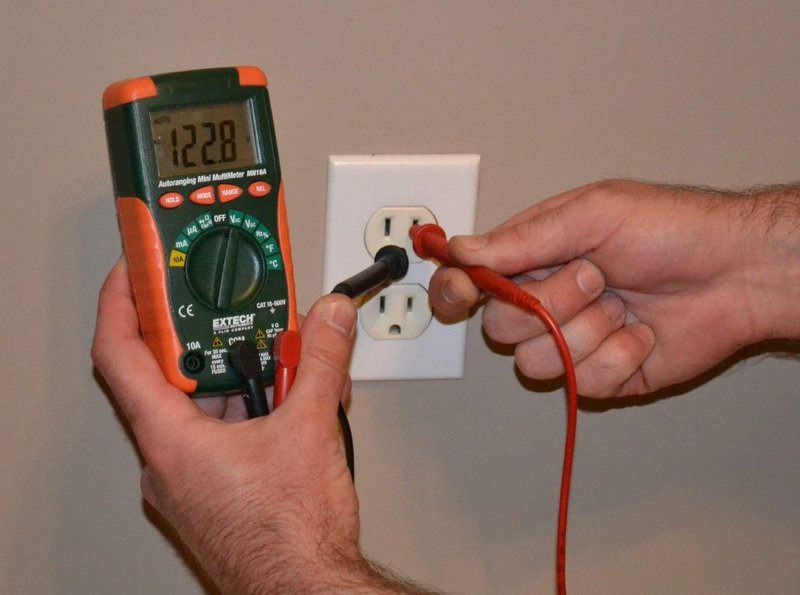
In this experiment, we will test the waters using a Voltage meter to check the voltage level of a battery. Any battery will do, even if it is a "dead" battey it will likely still register some voltage on your meter. To do this experiment, you must turn on your Voltage meter, to a VDC range setting that is rated for a voltage level that is higher than the (max) voltage of the source you are testing. So if you are testing a 9v battery, make sure you use a meter setting that is at least "10" or above.
I will go through and test three different battery types/sizes. First, I will test a standard 1.5v alkaline battery in the popular "AA" size. Making sure the meter is on the DCV setting (Direct Current Voltage), place the positive (red) test probe to the positive end of the battery and the black test lead to the negative side, you should see some value around 1.5v on your voltage meter:

You can check the rating for the battery you just tested to see if it is still good, though keep in mind a brand new or freshly charged battery may have up to a 10% higher voltage level than its rating (this is normal). Now I will test a 12v rechargeable Sealed Lead-Acid battery (SLA) commonly used in backup lighting and mobile power applications - repeat the same procedure to test, red to positive and black to negative:

And for the last battery, I will test the voltage from an 18v lithium battery pack from my Ryobi drill. The pack should read about 18 volts, but it has been used quite a bit and has not been recharged in a while, so it actually reads under 17 volts:

So that was easy right? No real risk of being shocked, so no problem. Well, this next section will deal with testing the voltage level from an alternating current power outlet in your home.
You can also check the voltage of your home wall outlets using your voltage meter on the VAC 120 or 240 setting (depending on your country's voltage level). It does not matter what orientation that you place the probes into the wall (red or black), but be VERY CAREFUL not to touch any metal that is touching the outlet contacts, and NEVER allow the two contacts of an electrical outlet to touch each other as this will cause a short circuit (sparks) and can cause harm to a human. As long as you are only touching the insulated plastic/rubber handles on your test probes, you will will be safe from electrical shock.
The left (larger) hole in the outlet is the "nuetral" wire that goes to your breaker box and connects to the same metal bar as the Ground wire - it is usually coated with white insulation. The right (smaller) hole in the outlet is the "phase" wire, which actually carries the 120VAC signal, is usually coated in black or red insulation, and is connected to a circuit breaker in your breaker box. If the load drawn on the circuit attached to that breaker gets above the circuit breaker rating (ie. 15amps), the circuit breaker will "trip" and disconnect or "open" the circuit. The bottom hole on the outlet is the "ground" wire that (as stated above) connects to the same place in the breaker box as the neutral wire - ground wires are usually uninsulated bare copper wire.
But why are the ground and neutral wires connected together in the breaker box, but run as separate wires to each outlet? This is because many appliances are metal, and since the neutral wire is insulated there is a chance that the phase wire (the hot wire) might come loose in the appliance and touch the metal casing - which would cause electrical shock if someone touched the metal casing of an appliance in this state. By running a ground wire separately, manufacturers can use it to connect to the metal casing of the appliance, so that if the phase wire comes loose and touches the metal casing, it would cause a short-circuit condition that would immediately trip the circuit-breaker and disable the circuit from harming/shocking anyone.
This means that your electrical outlet can be tested 3 different ways.
1. red test probe to "phase" wire (right hole) and black test probe to "neutral" wire (left hole). This should tell you the voltage level of your home (mine is 122.3VAC).
See the image below for a safe way to test the voltage level of an outlet (make sure voltage meter is on AC voltage setting):

2. red test probe to "phase" wire and black test probe to "ground" wire. This should also tell you the voltage of your home outlets.
See image below:

3. red test probe to "ground" and black test probe to "neutral". This should read 0v, since you are basically reading the same wire at two different ends - sometimes the electromagnetic field of the phase wire can case the voltage meter to read a small amount of voltage present between these two wires:

You may notice that while the average home electrical outlet in the USA might be rated for 120VAC, your house might read 117VAC or 125VAC as there are variations between different areas - this is normal.
Well, thats it for example #1 - We tested some various batteries and then a home electrical outlet. Remember to always check your voltage meter setting before testing an electrical source and NEVER touch any metal that is touching a high-voltage electrical contact!